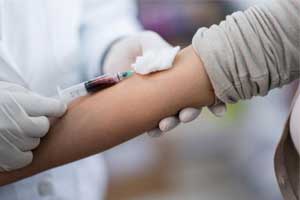- Home
- Editorial
- News
- Practice Guidelines
- Anesthesiology Guidelines
- Cancer Guidelines
- Cardiac Sciences Guidelines
- Critical Care Guidelines
- Dentistry Guidelines
- Dermatology Guidelines
- Diabetes and Endo Guidelines
- Diagnostics Guidelines
- ENT Guidelines
- Featured Practice Guidelines
- Gastroenterology Guidelines
- Geriatrics Guidelines
- Medicine Guidelines
- Nephrology Guidelines
- Neurosciences Guidelines
- Obs and Gynae Guidelines
- Ophthalmology Guidelines
- Orthopaedics Guidelines
- Paediatrics Guidelines
- Psychiatry Guidelines
- Pulmonology Guidelines
- Radiology Guidelines
- Surgery Guidelines
- Urology Guidelines
Handheld blood test device for rapid diagnosis of Heart attack

For the study, the researchers took blood from 776 patients traveling to hospital by ambulance in Denmark and then tested these samples for cMyC protein.
In patients who did suffer heart attacks, the protein was present in high enough concentrations 95 percent of the time for an on-the-spot diagnosis. Importantly, the cMyC test outperformed the existing troponin test, which was only capable of diagnosing around 40 percent of patients in this way. This is mainly because troponin takes longer to reach detectable levels in the blood after you suffer a heart attack.
The researchers now hope to work with industry to create a portable testing device to be used in UK A&E departments, and in ambulances in countries where these have to drive considerable distances to get patients to their nearest hospital. A simple handheld device could replace the time-consuming processes involved in sending samples to the hospital labs for analysis.
Under current guidelines, people suspected of having a heart attack are tested for high blood troponin levels as soon as they arrive in an A&E, and again after three hours. Depending on the type of troponin test used, up to 85 percent of people will need to remain in hospital for further tests in order to rule out a heart attack.
The cMyC blood test has already been shown to rapidly rule out a heart attack in more people than the standard troponin test. This could reassure worried patients in A&E departments, free up bed space and save hundreds of thousands of pounds per UK hospital every year.
Dr. Tom Kaier, one of the lead researchers, funded by the British Heart Foundation at St Thomas' Hospital, London said, "It is important for both patients and doctors to work out early who has had a heart attack and who hasn't.
"Now that we know that this test is sensitive enough to give an almost immediate heart attack diagnosis, we need to work on developing a testing device. We'd love to see this used in A&E departments within the next 5 years."
Professor Jeremy Pearson, Associate Medical Director at the British Heart Foundation, said:
"Big heart attacks are often easy to diagnose with an ECG but smaller heart attacks, which are more common and also life-threatening, are more challenging. The troponin test has been used for around 20 years and is currently the most powerful tool we have for diagnosing such heart attacks, but there is always room for improvement.
"These initial results with the cMyC test look very promising for patients, who could be more quickly diagnosed and treated or reassured and sent home. However, further research is necessary before it can be recommended as a replacement for the troponin test."

Disclaimer: This site is primarily intended for healthcare professionals. Any content/information on this website does not replace the advice of medical and/or health professionals and should not be construed as medical/diagnostic advice/endorsement or prescription. Use of this site is subject to our terms of use, privacy policy, advertisement policy. © 2020 Minerva Medical Treatment Pvt Ltd